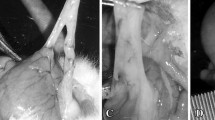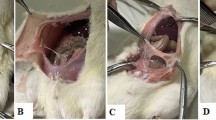Abstract
Background
Intra-abdominal adhesions are fibrous bands that develop after abdominal surgery or inflammation and cause significant surgical morbidity and mortality. In this study, the effectiveness of lidocaine, prilocaine and bupivacaine in preventing experimental intra-abdominal adhesions in rats was studied.
Methods
After obtaining the approval of our local institutional review board, 50 female Wistar-Albino rats weighing 250–320 g underwent laparotomy via a standard 5-cm midline incision under intramuscular anesthesia with ketamine (40 mg/kg) and xylazine (10 mg/kg). The cecal serosa and adjacent abdominal wall were superficially injured using sterile gauze. The laparotomy incision was closed after irrigation of the peritoneal cavity with the following: 5 ml saline in Group II, (the sham group), 7 mg/kg prilocaine in Group III, 3 mg/kg lidocaine in Group IV or 2 mg/kg bupivacaine in Group V. No irrigation was performed in Group I rats (the control group). After laparotomy closure, all rats were allowed to wake spontaneously. Two weeks after the initial experimental procedure, all rats underwent a second laparotomy, and adhesions were scored using the Linsky scale.
Results
The adhesion quantity and quality were comparable among all groups (P > 0.05); however, adhesion severity scores were significantly lower in the prilocaine and bupivacaine groups vs. the other groups (P < 0.05).
Conclusions
Prilocaine and bupivacaine were found to decrease the severity of intra-peritoneal adhesions.



Similar content being viewed by others
References
Menzies D, Ellis H (1990) Intestinal obstruction from adhesion how big is the problem? Ann R Coll Surg Engl 72:60–63
Ellis H, Moran BJ, Thampson JN et al (1999) Adhesion related hospital readmissions after abdominal and pelvic surgery: a retrospective cohort study. Lancet 353:1476–1480
De Cherney AH, Dizerega GS (1997) Clinical problem of peritoneal adhesion formation following general surgery and use of adhesion prevention barriers. Surg Clin North Am 77:671–688
Ivarsson ML, Holmdahl L, Franzen G, Risberg B (1997) Cost of bowel obstruction resulting from adhesions. Eur J Surg 163:679–684
Ray NF, Larsen JW Jr, Stillman RJ, Jacobs RJ (1993) Economic impact of hospitalisations for lower abdominal adhesiolysis in the United States in 1988. Surg Gyn Obs 176:271–276
Thompson JN (1995) Pathogenesis and prevention of adhesion formation. Br J Surg 82:3–5
Yilmazlar T, Kaya E, Gürpinar E, Emiroğlu H (1996) Efficacy of tenoxicam on intra-abdominal adhesion prevention in a rat model. J Int Med Res 24:352–357
Hollmann MW, Durieux ME (2000) Local anesthetics and the inflammatory response: a new therapeutic indication? Anesthesiology 93:858–875
Borg T, Modig J (1985) Potential antithrombic effects of local anaesthetics due to their inhibition of platelet aggregation. Acta Anaesthesiol Scand 297:739–742
Bredbacka S, Blombäck M, Hägnevik K, Irestedt L, Raabe N (2008) Per- and postoperative changes in coagulation and fibrinolytic variables during abdominal hysterectomy under epidural or general anesthesia. Acta Anaesthesiol Scand 30:204–210
Liebman SM, Langer JC, Marshall JS, Collins SM (1993) Role of mast cell in peritoneal adhesion formation. Am J Surg 165:127–130
Linsky CB, Diamond MP, Cunningham T, Constantine B, De Cherney AH, di Zerega GS (1987) Adhesion reduction in a rabbit uterine horn model using an absorbable barrier, TC-7. J Reprod Med 32:17–20
Ching SS, Muralikrisnan VP, Whiteley GS (2003) Relaparotomy: a five-year review of indications and outcome. Int J Clin Pract 57:333–337
Ar’Rajab A, Dawidson I, Sentementes J, Alsikes P, Harris R, Mileski W (1995) Enhancement of peritoneal macrophages reduces postoperative peritoneal adhesion formation. J Surg Res 58:307–312
Boland GM, Weigel RJ (2006) Formation and prevention of postoperative abdominal adhesions. J Surg Res 132:3–12
Gupta S, Jain PK (1985) Low-dose heparin in experimental peritonitis. Eur Surg Res 17:167–172
Türkçapar AG, Özarslan C, Erdem E, Bumin C, Ervedi N, Kutlay J (1995) The effectiveness of low molecular weight heparin on adhesion formation in experimental rat model. Int Surg 80:92–94
Tayyar M, Başbuğ M (1999) The effects of intraperitoneal piroxicam and low molecular weight heparin in prevention of adhesion reformation in rat uterine horn. Res Exp Med 198:269–275
Rejinen MM, Bleichrodt RP, Van Goor H (2003) Pathophysiology of intraperitoneal adhesion and abcess formation, and the effect of hyaluronan. Br J Surg 90:533–541
Ruetsch YA, Boni T, Borgeat A (2001) From cocaine to ropivacaine : the history of local anesthetic drugs. Curr Top Med Chem 1:175–182
Becker DE, Reed KL (2006) Essentials of local anesthetic pharmacology. Anesth Prog 53:98–109
Acknowledgments
This manuscript was edited by American Journal Experts. The authors wish to thank Dr. K. Bielecki for the thorough review of this manuscript.
Conflict of interest
The authors of this study have no financial disclosures or conflict of interest to declare.
Author information
Authors and Affiliations
Corresponding author
Rights and permissions
About this article
Cite this article
Ozturk, E., Yilmazlar, A., Berhuni, S. et al. The effectiveness of local anesthetics in preventing postoperative adhesions in rat models. Tech Coloproctol 14, 337–340 (2010). https://doi.org/10.1007/s10151-010-0644-6
Received:
Accepted:
Published:
Issue Date:
DOI: https://doi.org/10.1007/s10151-010-0644-6




